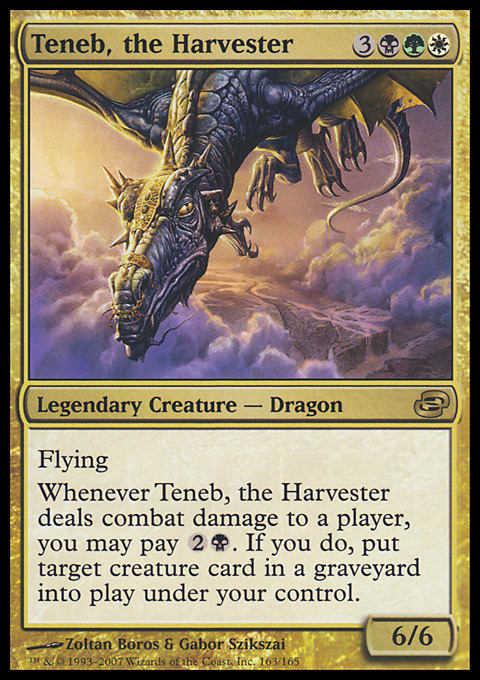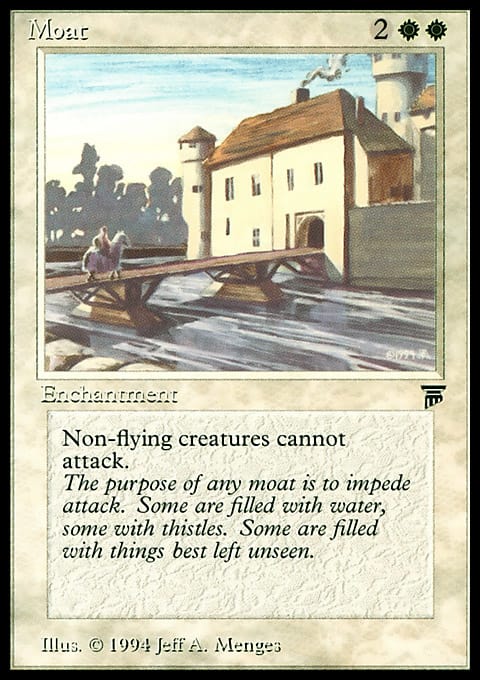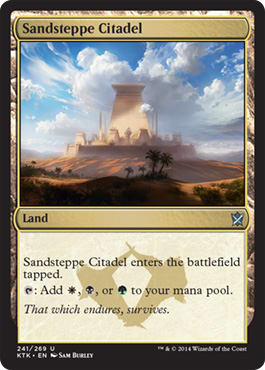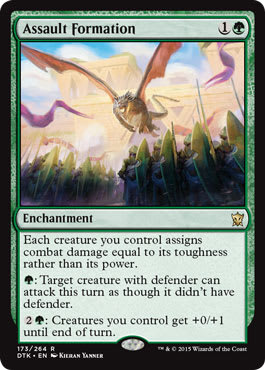About two weeks ago (as of this writing), I wrote my editor an e-mail with a very excited tone. “I know just what to do for Abzan!” (We’d been going back and forth, arguing merits of various Abzan commanders.) “Teneb Pillow Fort!”
My editor agreed it would be awesome. I set about researching cards, card choices, and prices.
For those of you who may not know or be sure, “pillow fort” is a style of play designed to discourage opponents from attacking the pillow-fort player. Some of the best-known pillow-fort cards are things like Moat and Forcefield ($320 and $140, respectively), but other cards, like Crawlspace, Propaganda, and Silent Arbiter, all make it difficult for people to either attack in general or attack the player. We build up a fortress, keep alive, and quietly win the game on our own terms.
Teneb is great for this style of play because the commander lets us not have to run win conditions—we can just steal them from other players as they beat each other up.
But we need to back up. The truth is that while we can definitely make some really powerful and capable decks on a limited budget, we are simply priced out of some things. Pillow fort is one of those things—some of the individual pieces aren’t too bad, but when every card costs between $3 and $10, we blow past $75 right quick.
On the positive side, though, the budget asks us to consider options we may not have if our card collection were really deep. When we don’t snap-add Sol Ring and Sensei's Divining Top to every stack, we look at other ways to find the mana and draw we need. And while our budget may not allow for traditional pillow_fort.dec, we can certainly build a deck that attempts to force the table into playing at our speed and still leverages our commander’s very powerful ability.
We’re going to play some powerful spells, and our commander isn’t cheap; plus, we’re sometimes going to want to activate Teneb’s ability and play something else in a turn, so we want to hit our mana drops and do some ramping. Whenever we have access to green, searching lands with spells is preferable to artifact mana because artifacts are destroyed a lot more often. Choosing extra lands also gives us more options for fixing, which is good because our colors are all over the place—35% of needed mana is [/mana]{B}[/mana], 33% is ![]() , and 32% is
, and 32% is ![]() .
.
So we run forty lands, twenty-three of which are basic. We have all the on-color Temples, check lands (Isolated Chapel, Sunpetal Grove, and Woodland Cemetery), and Guildgates in addition to the life-gain lands from Khans of Tarkir and the one from Zendikar (Graypelt Refuge). Sandsteppe Citadel makes us all our colors. Evolving Wilds and Terramorphic Expanse are fine, and Bojuka Bog serves as our only utility land—sometimes, getting rid of someone’s graveyard is the only way to stop that player.
We also have several ramp spells of different types. Kodama's Reach and Peregrination search for two lands each, Ondu Giant leaves behind a reasonably-sized blocker, and Mwonvuli Acid-Moss will get rid of someone’s Homeward Path—that card can wreck us. Frontier Guide is an interesting one—playing him on turn two and using his ability as much as possible once we have 4 mana will get us ahead in a hurry.
It’s worth noting the lands for this deck are quite expensive. Before building the mana base, the cost of this deck was right around $50, so the rest of the budget went to the more expensive lands. The deck could be built more cheaply and probably still be reasonable with different lands. Lands, however, are great investments—quality lands like the check lands and the Temples can go in every Commander deck with those colors, so acquiring them is kind of like an investment, and it’s among the best investments one can make in Magic.
The tag-team of Soul of the Harvest and Harvester of Souls can draw us a bunch of cards as creatures die, we cast them, and we steal them. Masked Admirers does some work, and since it can keep coming back, it can keep drawing. Hunter's Prowess also does amazing things, sometimes drawing an entirely new grip while simultaneously granting trample, which can be huge when we want to get in with Teneb. Wall of Mulch is an interesting way to draw some cards—particularly when someone blows up the board. Sac a Wall for each time you can make
Our primary threat comes from our commander and his ability; whenever possible, we want to steal our opponents’ dead creatures and beat them about the head with them. Sometimes, though, we just need some fat of our own, and a posse of Souls and Primordials does very nicely. Luminate Primordial makes sure a few creatures stay really dead, and Sepulchral Primordial does Teneb’s job without needing to hit. (If only Sylvan Primordial were legal . . . ) Soul of Zendikar, Soul of Innistrad, and Soul of Theros all have reasonable abilities and hit hard, and they can be used from the ’yard in a pinch.
We also have a bunch of answers. A few spot removal spells—Murder, Unmake, and Mortify, for example—join with a few additional enchantment-based removal options, such as Faith's Fetters, Prison Term, and the hilarious (and instant-speed) Temporal Isolation. Especially since tucking a commander is no longer possible, Faith's Fetters is among the best ways to stop a deck that wants to abuse the commander. We also have some catch-all answers like Acidic Slime, Oblivion Ring, and Banishing Light to get rid of obnoxious things such as Eldrazi Monument and Sorin Markov. Krosan Grip can be amazing—take that, Argentum Armor!
And we have Wrath effects for days. There are ten Wrath effects in this deck, so don’t be shy about blowing up the board. Day of Judgment is the cheapest, In Garruk's Wake is the most brutal, and Duneblast is one of the reasons to play this color combination. Necromantic Selection and Phyrexian Rebirth should leave us in a pretty good spot, Decree of Pain makes sure we have plenty of options going forward, Life's Finale gives us extra juicy targets for Teneb, and Crux of Fate and End Hostilities just kill creatures dead. Fated Retribution fires off at instant speed, which can be devastating for the player who just dumped all his or her resources into a hasty token army.
Beacon of Unrest can do a lot of great work in a deck like this; when that Argentum Armor winds up in a graveyard, the Beacon can go grab it. It can just grab a big dude, too. The fact that it shuffles back in makes it worth the $6. Teneb already flies, but we have a couple of ways to give him some evasion. Chariot of Victory is excellent here because not much will stop a first-striking hasty flyer with trample. We also have Dauthi Embrace, which gives Teneb shadow, effectively making the Dragon unblockable. (Watch out if Temporal Isolation is on something that flies though!) Enslave is a strange color-shifted steal effect, but we sometimes don’t want to wait to kill the thing—we just want the thing.
We have a Defender subtheme, too. They’re cheap, effective ways to keep other players off our backs, especially in the early game, and by the time we’re ready to Wrath, we don’t care about them anymore. They also have some good functionality—Wall of Reverence, for example, gains us life every turn, Archers' Parapet is a funny way to deal some damage, and Cathedral Membrane does a good job of killing something dead. It’s also hilarious to play out Hornet Nest when someone just cheated in a 9/9 or whatever—sure, go ahead and attack. Remember that Teneb can bring back the Walls—or any other creature in our ’yard—too. Sometimes, our graveyard may have the only targets.
Finally, Norn's Annex is the only piece of true pillow-fort tech left in the deck. Even if someone has the ![]() rather than having to play life, it becomes very hard to attack, and most decks will come up with reasons to attack other players as long as the Annex is on the field.
rather than having to play life, it becomes very hard to attack, and most decks will come up with reasons to attack other players as long as the Annex is on the field.
Teneb, the Harvester ? Commander | Mark Wischkaemper
- Commander (0)
- Creatures (28)
- 1 Acidic Slime
- 1 Angelic Wall
- 1 Archers' Parapet
- 1 Farhaven Elf
- 1 Fertilid
- 1 Frontier Guide
- 1 Gatecreeper Vine
- 1 Harvester of Souls
- 1 Hornet Nest
- 1 Luminate Primordial
- 1 Masked Admirers
- 1 Ondu Giant
- 1 Reclamation Sage
- 1 Sepulchral Primordial
- 1 Soul of Innistrad
- 1 Soul of the Harvest
- 1 Soul of Theros
- 1 Soul of Zendikar
- 1 Sunweb
- 1 Trestle Troll
- 1 Wall of Essence
- 1 Wall of Glare
- 1 Wall of Mulch
- 1 Wall of Reverence
- 1 Wall of Shadows
- 1 Burnished Hart
- 1 Cathedral Membrane
- 1 Wall of Tanglecord
- Spells (31)
- 1 Abzan Charm
- 1 Fated Retribution
- 1 Krosan Grip
- 1 Mortify
- 1 Murder
- 1 Unmake
- 1 Beacon of Unrest
- 1 Crux of Fate
- 1 Day of Judgment
- 1 Decree of Pain
- 1 Dregs of Sorrow
- 1 Duneblast
- 1 End Hostilities
- 1 Explosive Vegetation
- 1 Hunter's Prowess
- 1 In Garruk's Wake
- 1 Kodama's Reach
- 1 Mwonvuli Acid-Moss
- 1 Necromantic Selection
- 1 Peregrination
- 1 Phyrexian Rebirth
- 1 Banishing Light
- 1 Dauthi Embrace
- 1 Enslave
- 1 Faith's Fetters
- 1 Khalni Heart Expedition
- 1 Oblivion Ring
- 1 Prison Term
- 1 Temporal Isolation
- 1 Chariot of Victory
- 1 Norn's Annex
- Lands (40)
- 7 Swamp
- 8 Forest
- 8 Plains
- 1 Blossoming Sands
- 1 Bojuka Bog
- 1 Evolving Wilds
- 1 Golgari Guildgate
- 1 Graypelt Refuge
- 1 Isolated Chapel
- 1 Jungle Hollow
- 1 Orzhov Guildgate
- 1 Sandsteppe Citadel
- 1 Scoured Barrens
- 1 Selesnya Guildgate
- 1 Sunpetal Grove
- 1 Temple of Malady
- 1 Temple of Plenty
- 1 Temple of Silence
- 1 Terramorphic Expanse
- 1 Woodland Cemetery
With a slightly larger budget, scrap the Norn's Annex for an Aura Shards. Wrath of God is better than Crux of Fate. With a ton of money, the entire Wall theme could go and be replaced with pillow-fort effects like Crawlspace and Ghostly Prison, though part of the charm of this deck is that it does something rather unusual. Souls of the Faultless was just barely too expensive, but it would probably be better than Wall of Essence. And my editor thinks Thallid Shell-Dweller should be in the deck.
One could also add Doran, the Siege Tower and Assault Formation. Going a little deeper into defenders would probably be good at that point, but it could be a very surprising direction and lead to some really hilarious wins.
Playing this deck will be a good mental challenge. Often, we’ll start with a Wall and a ramp spell, but after that, it starts becoming tricky. When do we Wrath? When do we commit our commander to the board? When do use our spot removal instead of just Wrathing? What do we grab, and how angry will it make the player we grabbed it from? What artifact or enchantment is good enough to use Acidic Slime? Try to use as much mana as possible each turn, and think about how best to keep the game under control. Given enough time, this deck will have a hard time losing; figuring out how to survive that long is the puzzle.
Is there a way to build pillow fort on a budget? I’d love to hear it. Also, I think this deck is 75%—it skews toward power, not consistency, it uses opponents’ resources against them, and it punishes people rather than stops them. Do you agree?
Decks like this can be really fun to pilot and to play against. It’s also interesting when limitations force deck-building to be different than expected. Sometimes, an oblique angle is the shortest distance to a victory.
Total cost: $74.57































